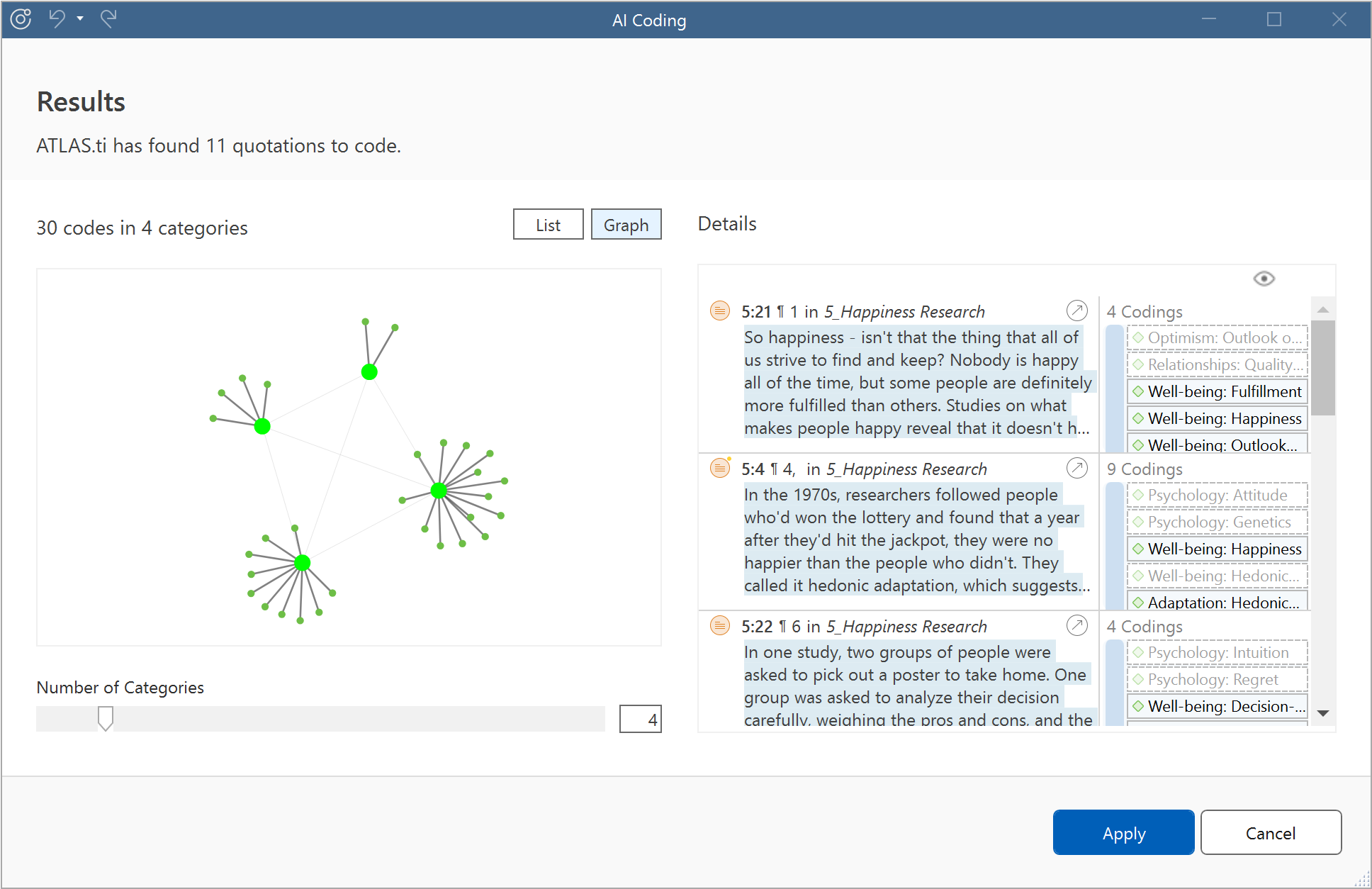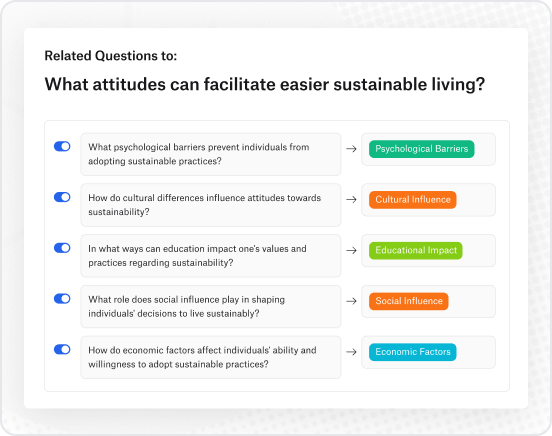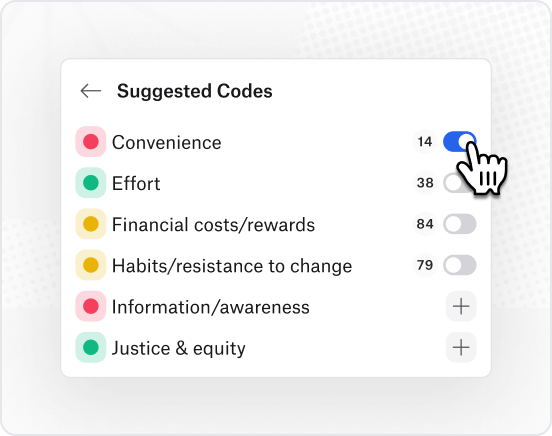Introducing: AI Coding Beta powered by OpenAI
Say goodbye to tedious analysis tasks and increase your coding speed with our AI-driven assistance. We are proud to announce a groundbreaking step in the field of qualitative data analysis: AI Coding Beta – our new solution that makes full-automatic data coding a reality, fueled by OpenAI’s GPT model.

- The beginning of the world’s first AI solution for qualitative insights
- Get results in a fraction of the time compared to other software
- Fine-tune AI Coding in ATLAS.ti Desktop
- ATLAS.ti & OpenAI: The future of data analysis
- Now available for Win, Mac and Web
- Unlocking AI Power for Qualitative Insights - An Interview with ATLAS.ti CEO Jörg Hecker
- The Modern Qualitative Researcher's Ally: AI Coding Beta, Your New Thinking Partner
- AI Data Security and Privacy at ATLAS.ti
- FAQ
The beginning of the world’s first AI solution for qualitative insights
Get results in a fraction of the time compared to other software
Gone are the days of countless hours spent manually coding data. With AI Coding Beta, ATLAS.ti offers the first AI assistance to automatically perform open and descriptive coding for your text material, saving you enormous amounts of time and energy. This way, you can focus on the important things – analysis and interpretation of your data for better and faster insights.
Maintain full control for optimized scientific accuracy
Think of it as your personal research assistant: AI Coding Beta generates fully automated code proposals while allowing you to review and refine results quickly – ensuring 100% transparency and human supervision.
Your key benefits:
- Reduce your overall data analysis time by up to 90% ⏱️
- Unlike other software solutions, don't worry about endless manual coding 😌
- Increase the accuracy of your results thanks to OpenAI’s model 🤖
- Check the results at any time and simply refine codes and quotations 🎚️
- Uncover insights and patterns that otherwise may have been missed 💎
- Focus on interpreting your data rather than spending weeks on work 🔍
- AI Coding is optional you can always use our wide array of other tools 🧰
Please note: AI Coding is currently in Beta. You may experience slower response times during that stage due to high demand. We're working hard to improve performance.
🆕 Fine-tune AI Coding in ATLAS.ti Desktop
With our new slider control in ATLAS.ti Desktop, you can now customize the granularity of AI Coding results based on your specific needs. Get fewer, broader categories or more fine-grained, nuanced ones with just a click. View an interactive graph that visualizes your coding clusters for full transparency. Achieve the ideal balance of automatic support and human refinement.

ATLAS.ti & OpenAI: The future of data analysis
At ATLAS.ti, we believe that AI will change how people approach data analysis, making it faster and more efficient than ever. As the first and only software provider in our sector, we have integrated and tailored OpenAI's GPT model, which is known for its ability to understand and interpret language at a human-like level.

OpenAI is considered one of the world's leading research organizations in artificial intelligence. Our experts have spared no time or effort to optimize the integration, providing astonishing results for our users. By leveraging OpenAI technology, we can ensure that your data will be coded accurately and efficiently.
Coming soon: In the near future, we will also allow you to work with your own code sets, making the solution even more powerful.
Now available for Win, Mac and Web
Designed for students, researchers, and businesses alike, ATLAS.ti makes data analysis easier and more accessible than ever before. We are excited to see the impact that AI Coding will have on the future of qualitative data analysis.
You can now try AI Coding Beta in our desktop apps on Windows and macOS or our Web version for browsers. Get started today!

FAQ
How does AI Coding work?
Analyzing documents using inductive coding can be a daunting task. It takes a long time, and you need to keep an alert eye. Our AI-driven assistance helps you by automatically analyzing your texts. It breaks down your text into paragraphs, creates quotations from those paragraphs, and automatically applies inductive codes to every quotation.
After analysis, AI Coding provides an intuitive interface to review the codes, add or remove codes, remove quotations, or rename codes. All codes used in AI Coding can be found in the code group ‘AI Codes’ so you can easily continue your research.
What happens with my data?
If you do not use AI Coding, none of your data will be uploaded to OpenAI.
Before starting AI Coding, ATLAS.ti will ask for your consent before uploading data to servers by ATLAS.ti, as well as OpenAI servers.
ATLAS.ti has an opt-out agreement with OpenAI. This means your data will not be used for OpenAI model training. OpenAI will forget your data after AI analysis.
For more information regarding privacy and GDPR compliance, please see our Licensing Conditions and Terms of Use (EULA) and Privacy Policy.
How do OpenAI and GPT models work?
GPT models by OpenAI are highly advanced language models that have been designed to enable organizations and researchers to create innovative AI applications that are both safe and beneficial to humanity.
Here are some key facts about GPT by OpenAI:
GPT is a generative pre-trained transformer (GPT) that has been fine-tuned on a massive scale, using supervised and reinforcement learning algorithms to improve performance. This means that the models have been trained using both human trainers and advanced machine-learning techniques to enhance their language capabilities. The GPT models are designed to analyze text with high accuracy and have been trained using a large corpus of text created by humans. This ensures they can understand and process text in a way consistent with human thinking patterns.
OpenAI uses cutting-edge techniques such as reinforcement learning, deep learning, and transfer learning to train its models. These techniques are backed by rigorous scientific research and testing, ensuring the models are highly accurate and reliable.
Artificial intelligence and machine learning are rapidly evolving fields of study. OpenAI is constantly working to improve their Services to make them more accurate, reliable, safe and beneficial. Given the probabilistic nature of machine learning, the use of our services may in some situations result in incorrect output that does not accurately reflect real people, places, or facts. You should evaluate the accuracy of any output as appropriate for your use case, including by using human review of the output.
Are there any restrictions?
Please keep in mind that AI Coding uses artificial intelligence. Therefore, some safeguards need to be in place. For example, we might block the following types of content: hate, harassment, violence, self-harm, sexual, political, spam, deception, and malware.
Note that each time you use AI Coding, the results for automatically generated codes may differ for the same material. If you ask a human the same question twice, you will not get 100% mechanically similar results. AI Coding will also not give you 100% exactly the same results every time.
In some cases, GPT models encode social biases, e.g. via stereotypes or negative sentiment towards certain groups.
AI Coding proposes codes for the paragraphs in your texts. The results are based on "reading between the lines" in these paragraphs. AI Coding was tested on scientific texts, closed and open-ended interviews and delivered high-quality results. As a solution driven by artificial intelligence, AI Coding might produce bias, "hallucinations," and other undesired outputs. Check your results at the end of the analysis.
In the trial version, AI Coding is limited to 6000 to 12.000 words (depending on language and text formatting). To be able to perform AI Coding multiple times, we therefore recommend testing with documents under 500 words.
AI Coding can only be used in the following countries and regions





